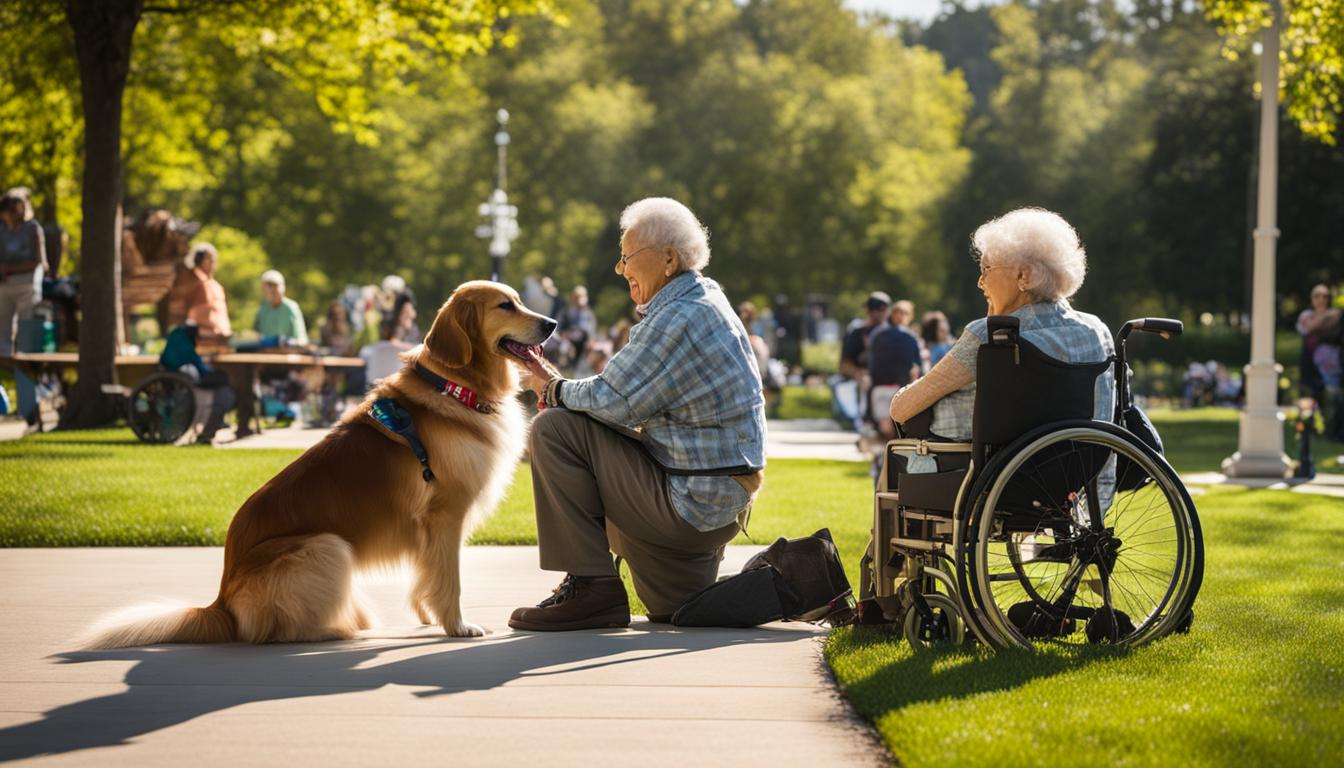Therapy and service dogs have an incredible ability to positively impact both the physical and mental well-being of individuals. Whether they are personal pets or trained therapy animals, these dogs have the power to create a culture of safety and healing in therapy settings. Their presence can help alleviate stress, anxiety, and depression on a chemical level, while also providing comfort to those who have experienced trauma. Therapy dog programs are on the rise, as more and more clinical practices and organizations recognize the breakthroughs and improved therapeutic ambiance these animals bring.
Key Takeaways:
- Therapy and service dogs have a transformative impact on individuals’ mental and physical health.
- These dogs create a culture of safety and healing, reducing stress, anxiety, and depression.
- Therapy dog programs are growing in popularity in clinical practices and organizations.
- Therapy dogs provide comfort and support, especially for individuals who have experienced trauma.
- The integration of therapy and service dogs into society is changing lives and fostering emotional well-being.
Therapy Dogs in Clinical Practice: Personal Pets as Co-Therapists
Therapists are finding innovative ways to enhance the therapeutic experience for their clients by incorporating their own personal pets as co-therapists. These therapy dogs provide a unique form of canine-assisted therapy, creating a warm and welcoming environment in clinical settings. Research has shown that therapy dogs can have a profound impact on reducing stress, anxiety, and depression, making them valuable companions in therapy sessions.
These personal pets-turned-co-therapists have a remarkable ability to create a culture of safety and healing. Their calming presence helps clients feel at ease, fostering a sense of trust and comfort. Therapy dogs have an intuitive nature that allows them to connect with individuals, especially those who have experienced trauma. Through their gentle demeanor and unconditional love, these dogs can help clients open up and share their feelings, facilitating breakthroughs in therapy.
Many therapy practices have adopted therapy dogs as “mascots” to enhance the therapeutic environment and provide a sense of comfort for clients. These dogs not only bring joy and companionship but also serve as an invaluable tool in promoting emotional well-being. With their involvement, therapy dogs are becoming increasingly recognized for their positive impact on society, highlighting the benefits of community therapy dog programs and the importance of service dog community involvement.
Table: Community Benefits of Therapy Dogs in Clinical Practice
| Benefit | Description |
|---|---|
| Stress Reduction | Therapy dogs help lower cortisol levels, reducing stress and promoting relaxation. |
| Anxiety Relief | Interacting with therapy dogs can decrease anxiety symptoms and provide a sense of calm. |
| Depression Alleviation | The presence of therapy dogs can improve mood and decrease depressive symptoms. |
| Comfort and Support | Therapy dogs create a culture of safety and provide unconditional love and comfort to clients. |
| Enhanced Therapeutic Ambiance | Therapy dogs contribute to a warm and welcoming environment, promoting healing and emotional well-being. |
As therapy dogs continue to make a meaningful impact in clinical practice, their role as personal pets-turned-co-therapists is gaining recognition. These furry companions improve the therapeutic ambiance, support clients in their healing journey, and contribute to the overall well-being of individuals in therapy. The community benefits of therapy dogs in society are evident, highlighting the importance of their involvement and the value of community therapy dog programs.
Service Dogs in Correctional Settings: Supporting Mental Health and Trauma Recovery
Service dogs have proven to be invaluable in correctional settings, where individuals often struggle with mental health, addiction, and trauma. The use of therapy dogs in prisons and correctional institutions is a growing trend, as the positive impacts on inmate well-being and rehabilitation become increasingly evident. These dogs play a crucial role in offering support, comfort, and a sense of safety to individuals who have experienced trauma.
Research has shown that therapy dogs in correctional settings lead to increased feelings of safety, trust, and transparency among inmates. They create a therapeutic environment that promotes healing and emotional well-being. Through a trauma-informed approach, therapy dogs assist in addressing the consequences of trauma and facilitate the therapeutic process. Their presence helps individuals connect with others, open up to their therapists, and foster the development of coping skills necessary for successful reintegration into society.
In addition to their impact on mental health and trauma recovery, service dogs in correctional settings also play a role in community involvement. These programs provide inmates with the opportunity to develop valuable skills in animal care and training. By participating in service dog outreach programs, inmates not only contribute to the well-being of the community but also gain a sense of purpose and responsibility. The presence of therapy dogs in correctional facilities improves the overall culture and atmosphere, contributing to a more humane and rehabilitative environment.
The Role of Service Dogs in Correctional Settings
Service dogs fulfill various roles within correctional settings that support mental health and trauma recovery. These roles include:
- Providing emotional support and comfort to individuals who have experienced trauma.
- Helping to reduce stress, anxiety, and depression among inmates.
- Facilitating therapeutic breakthroughs and promoting a sense of safety and trust.
- Assisting in the development of coping skills necessary for successful reintegration.
- Encouraging community involvement and teaching valuable skills in animal care and training.
Service dog programs in correctional settings have demonstrated significant benefits for both inmates and the communities they will eventually reintegrate into. The use of therapy dogs in prisons not only supports mental health and trauma recovery but also contributes to the overall well-being and rehabilitation of individuals in the correctional system.
| Program Impact | Service Dog Outreach Programs | Service Dog Roles in Communities | Service Dog Community Involvement |
|---|---|---|---|
| Improved mental health and well-being of inmates | Opportunity for inmates to contribute to the community | Emotional support and comfort to individuals in need | Teaching valuable skills in animal care and training |
| Increased feelings of safety, trust, and transparency in correctional settings | Development of a sense of purpose and responsibility among inmates | Reduced stress, anxiety, and depression among community members | Promoting a more humane and rehabilitative environment |
Conclusion
Therapy and service dogs have made a lasting impact on the well-being of individuals, both mentally and physically. Their unique ability to provide comfort, support, and a sense of safety has transformed the way we approach therapy and healing.
Whether in clinical practice or correctional settings, these remarkable dogs have become invaluable assets in supporting individuals with mental health, addiction, and trauma concerns. Their presence has proven to be a catalyst for breakthroughs, facilitating the therapeutic process and fostering emotional well-being.
As the benefits of therapy dogs continue to be recognized, the demand for therapy dog initiatives and programs is growing. It’s clear that integrating therapy and service dogs into society is changing lives and creating a culture of healing and compassion.
So, let’s embrace the power of these furry companions and strive to implement therapy dog initiatives in various settings. Together, we can make a difference and bring about positive change in the lives of those who need it most.





